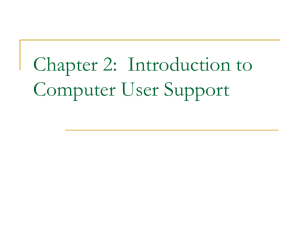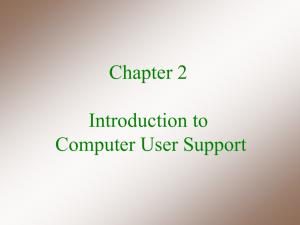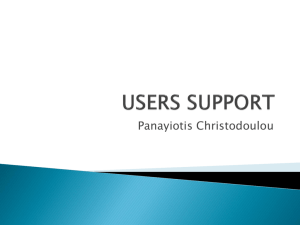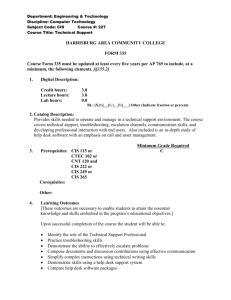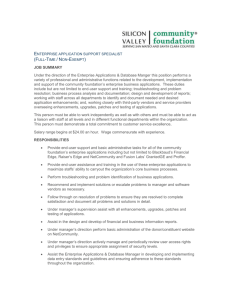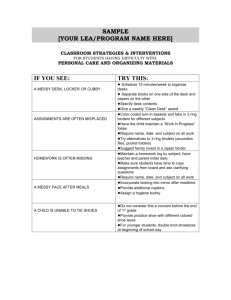ch01
advertisement
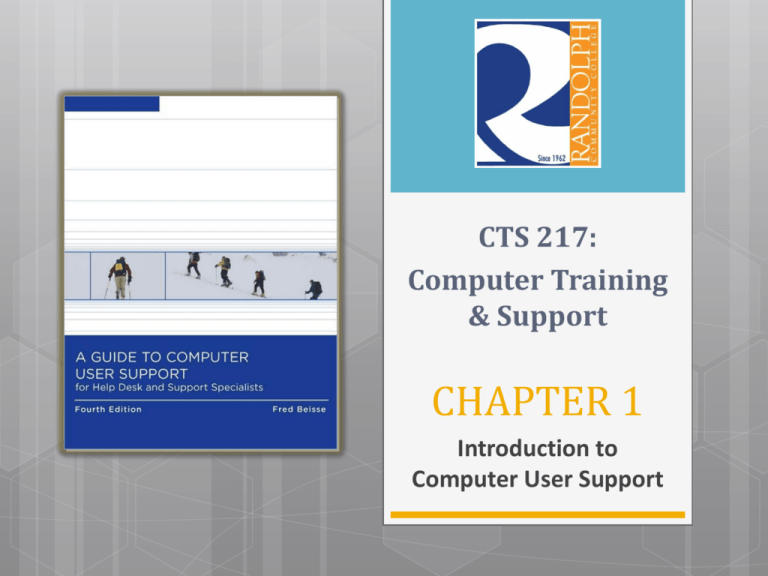
CTS 217: Computer Training & Support CHAPTER 1 Introduction to Computer User Support Chapter Objectives In this chapter, students will learn about: How historical changes in computer technology have affected computer use Ways to classify end users Resources computer users need and major categories of end-user software Common problems users encounter The job market demand for user support workers Chapter Objectives In this chapter, students will learn about: Common ways to organize and provide support services Typical position descriptions for user support staff The knowledge, skills, and abilities for an entrylevel support position Career paths for user support workers Historical Changes in Computer Use End-user computing: the use of computers for both business and personal use All levels of organizations today Home, school, government Summary by decades on next slide Milestones in the Adoption of CT Decade Primary Types and Uses of Computer Systems 1940s • Invention of CPUs and peripherals 1950s • Early use of large computers in large corporations • Widespread use of large-scale computers • Early use of smaller, workgroup computers 1960s 1970s • Widespread use of workgroup computers • Terminal access to large-scale and workgroup computers Milestones in the Adoption of CT Decade Primary Types and Uses of Computer Systems 1980s • Widespread use of home and business PCs • Availability of mass-market applications software and GUI operating systems • Early data communications and networks • Widespread use of local area and wide area networks • Distributed computing • Rapid growth of the Internet • Increased business use of the Internet • Availability of very low-cost PCs • Development of wireless technologies 1990s 2000s 6 1980s and 1990s: Growth of Decentralized Computing Applications backlog: lots of apps needed, shortage of programmers FRUSTRATING Knowledge worker: employees whose primary job is to collect, prepare, process, and distribute information Accountant, Database report writer 1980s and 1990s: Growth of Decentralized Computing Declining PC costs: microcomputer (PC), smaller scale, easier to put on desk, “toy” computers 1980s and 1990s: Growth of Decentralized Computing Inexpensive productivity software: spend more on programming than hardware; massmarket apps such as WordStar, Lotus 1-2-3, and dBASE) alleviated need for programmers 1980s and 1990s: Growth of Decentralized Computing User friendly GUIs: menus, screen images, point-and-click 1990s and 2000s: Distributed & Network Computing Join large-scale and workgroup computing network servers (TP and storage) and desktop PCs (log in to servers and local productivity software) Wired, wireless, Internet … connectivity Data or IT Processing (60s and 70s) now called IS Classifying End Users Environment: home/non-business or work/business Skill level: novice vs. highly skilled Frequency of use Software used: WP, SS, email, DB, games Features used: basics, intermediate, power users Relationship: internal vs. external Several categories? yes Resources End Users Need $500 computer = a good deal, right?? Basic hardware (components in case, input devices, output devices) Add-on peripherals: camera, scanner, modem H/W maintenance and upgrades: warranty (business is better); upgrade RAM/HDD? Resources End Users Need Software upgrades “Useless” trial versions Multiple operating systems (use virtual) Virus scan Supplies: CDs/DVDs, paper, printer cartridges) Data and information: monthly ISP fee, subscription to help services or databases Resources End Users Need Technical support: includes installation assistance, training courses, books, magazines LD charges, per call cost Training vs. trial and error Facilities, administration, overhead Furniture, utilities, devices, space Supervisors and overhead Total Cost of Ownership (TCO) End-User Application Software Increase productivity Email and instant messaging Web browser (IE, Firefox, Safari) Word processing (Word 2010) Spreadsheets (Excel 2010) Database management (Access 2010) Graphics (GIMP) Planning and scheduling (Project 2010) Desktop publishing (Publisher 2010) End-User Application Software Increase productivity Web site development (Dreamweaver, Expression Web, FileZilla) Education and entertainment software (MyITLab, games) Enterprise apps (Abra, FourthShift) Industry-specific apps (Meditech) Can justify purchases with increased efficiency of workers Problems End-Users Experience Waste of resources Purchase incompatible software due to inexperience Fix it yourself instead of calling support User mistakes Wrong formulas in Excel Forget to create backups Computer crime Sell company info to another company Phishing victim Problems End-Users Experience Theft of resources Piracy: illegal distribution of software Violate computer use policy Install software to work at home – theft?? Invasion of privacy Medical info files Spyware tracks history of purchases Abusive users Sending unwanted personal emails Displaying offensive wallpaper or screen saver Problems End-Users Experience Computer viruses Malicious intent, destroy info, corrupt software User downloads and it spreads through network Forwarded email attachment Forwarding virus warning hoaxes (snopes.com) Health problems Carpal tunnel syndrome: hand and wrist pain Back and neck aches Lack of ergonomic (promotes safety) office furniture Addressing the Need for US Workers Provide ongoing assistance so that computers are tools, not hindrances 1st decade of 21st century: Hiring decreased in 2001-2003 Tech support jobs sent to India Contract with temp agencies Increased demand in some org. due to mobile technologies and security How Org. Provide a US Function Computer user support is a job function or department in an organization that provides information and services to employees and/or customers to help them use computers more productively Deals with a broad spectrum of support issues Technical support is a level of user support that focuses on higher-level troubleshooting and problem solving Deals with difficult and complex problems users encounter How Org. Provide a US Function Common names for user support Customer Service Help Desk Technology Support Services Client Support Services Computer Assistance Computer Help Hotline Call Center Information Center How Org. Provide a US Function Peer support is an informal level of user support Coworkers in an organization or department exchange information and provide assistance about computer use and problems encountered by other users No special training or preparation required Enjoy sharing expertise / have more experience Help classmates in class or lab How Org. Provide a US Function Part Responsibility for user support is formalized in an existing employee’s position description time user support Expertise recognized and rewarded Can make significant demands on worker’s time and compete with other assigned tasks Stretched too thin? How Org. Provide a US Function User support worker or work team Frequently occurs when part-time, informal peer support cannot meet support demands Alternatives: Full-time support position Organize part-time workers into a user support team (formal workgroup to provide user support Outsource support needs How Org. Provide a US Function Help A help desk provides a single point of contact for users in need of technical support Manages customer problems and requests and provides solutions-oriented support services desk support Refer to someone else if cannot solve May be a: physical location a telephone number (hotline) an e-mail address an online chat session a Web site http://www.3mit.com/support/ How Org. Provide a US Function User A user support center provides a wide range of services to an organization’s computer users support center Consulting on product purchases Training and documentation on supported products Help desk operation Facilities management Hardware repair services Also called an information center How Org. Provide a US Function User support outsourced to a vendor Outsourcing involves a contract with a vendor that specializes in support services Advantage: Controls costs while taking advantage of external expertise Disadvantages: Relies on telephone, e-mail or Web contacts rather than on-site access Costs are predictable, but not necessarily lower Little transfer of knowledge to in-house staff Lack of personal relationship between users and support staff How Org. Provide a US Function User support as an IS responsibility Support is provided: Directly by technical IS staff By a separate group within IS Advantage: Provides single point of contact for problems Disadvantage: Conflicts with other IS employee work assignments Some “geeks” just don’t have the communication skills needed User Support Services User Support Services Staff HD, Hotline, or Chat Session Respond to requests for product information Market products and services Provide solutions to problems Receive and log user complaints about product features Handle warranties and product returns User Support Services Provide Deals with more difficult problems that technical troubleshooting assistance are beyond the immediate services a help desk can provide need a high level of expertise Examples Hardware problem diagnosis Repair, replace, fix, provide workarounds for difficult applications software and network problems User Support Services Locate information to assist users Access, search for, locate, and work with information to solve a problem Resources Printed materials from vendors Trade and text books Online help CD-ROM databases Internet Web sites Point them to page number Look up error message Automated telephone voice-response units User Support Services Evaluate hardware, software and network products Issues to evaluate: Increase Productivity? Compatible? Timing (everyone upgrade)? Useful features? Cost effective? You choose = you support > cost, compatibility issues, wastes time User Support Services Coordinate standards Support Standards are lists of computer products that an organization recommends to its employees and that it will support organization-wide support Business PCs, software, networking equipment Goal: To limit the hardware and software products a support staff must be able to support to reduce support costs NOT experts on EVERYTHING! User Support Services Perform needs assessment and purchase assistance Also called a needs analysis Investigate and determine the features and configuration of hardware and software that will best meet a user’s needs May also include justifying the purchase how to place an order how to pay for the system preparing paperwork User Support Services Provide installation assistance Purpose: efficient use of staff resources Strategy: User support staff have tools and expertise to unpack, set up, install, and configure a system Network configuration Peripheral devices Transfer data from old PC Computer facilities mgmt N/W security, backups, virus scan, PM User Support Services Provide training on computer systems and procedures Goal: To make effective use of a new or upgraded system Examples Basic, introductory classes Groups or one-on-one Advanced training This class: create tutorials with Camtasia User Support Chapter 10 User Support Services Prepare documentation on computer use Training is one-time; documentation is always available Example documents: Introductory, “how-to” manuals Tutorials and reference manuals Organizational computer use guidelines Online documentation, such as FAQs and wizards Email responses User Support Chapter 11 Prepare documentation for simple process and present to class User Support Services Assist Solve specific business problems or meet information requirements Software development is a potential source of conflict between IS department staff and support center staff users with software development projects Compatibility Design standards Documentation Security Emphasis is on assisting users with applications development, rather than developing applications Provided to a limited extent by many user support centers Position Descriptions Position description: written description of the qualifications and responsibilities for a job in an organization Read and tailor your résumé around it Figure 1-7 p. 33 Help Desk Support Rep Wide range of activities Figure 1-8 p. 34 IT Specialist (Network) Compare responsibilities in the two positions Knowledge, Skills, Abilities Analyze position descriptions for KSAs: Knowledge – what do I need to know Skills – what do I need to be able to do well Abilities – what special tasks or skills do I need to be able to perform Note: the difference between skills and abilities is blurred in everyday use Customize your résumé to match KSAs employer needs! KSAs - Knowledge What an employee must know May be stated as: specific number of years of education a degree in a specified field list of topics Examples Knowledge of basic computer operation Knowledge of application software package (e.g., Excel) KSAs - Skills Tasks an employee must be able to perform well Can be attained through practice or experience Examples Skill in troubleshooting hardware and software Skill in configuring desktop computers to optimize performance KSAs - Abilities A special task or skill a support specialist either has or does not have Often state as ability to perform a specific task Examples Ability to lift 50-pound boxes Ability to communicate with users in Spanish Ability to work as a member of a team Ability to write documentation How to get KSAs Few support employees have every KSA they need on day 1 Learning resources: Employer training and orientation classes Continuing education On-the-job learning Community College classes Vocational-technical school classes Industry training and certification classes Role-playing scenario p. 38 Alternative Career Paths for User Support Workers Computer programmer/developer Network support technician Web site maintainer User support manager/supervisor Project manager Trainer / technical writer Computer security specialist Chapter Summary Early computers were large, centralized corporate or government systems used to automate manual tasks Several industry trends during 1970s and 80s resulted in end-user personal computers End users can be categorized according to: Environment Skill level Frequency of use Software used Features used Relationship to support Resources that impact total cost of ownership: Hardware Peripherals Software Upgrades Maintenance Supplies Data and information Facilities Technical support Chapter Summary (continued) End-user software includes: E-mail Instant messaging Web browser Word processor Spreadsheet Database manager Graphics Planning/scheduling Desktop publishing Web page developer Education/entertainment Enterprise/industry-specific Primary goal of end-user computing: make users more productive Common problems related to end-user computing: Wasted resources User mistakes Computer crime Piracy Invasion of privacy Abusive use Computer viruses Health problems Chapter Summary (continued) Ways to organize end-user assistance Peer support Part-time support User support group Help desk User support center IT department staff Outsource to vendor Support services users need: Help desk Troubleshooting Locate information Product evaluation Support standards User needs assessment System installation Training Documentation Facilities management Software development User support positions require a variety of knowledge, skills, and abilities (KSAs) that may lead to alternate career paths
